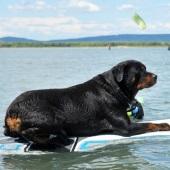A Dog of Whom If Not Saved...

Like us, during the warm summer days, dogs need a shaded, ventilated, and cool place, and during the winter, a warm, dry, and cozy place. The puppy needs a permanent place to feel secure. The bedding should be soft. In the first nights, the puppy might cry. It can be soothed with a warm water bottle, a toy, etc. It is not recommended to approach the puppy every time it cries in the first days.
How to approach an injured animal?
When approaching an injured animal, be cautious: even an animal known for its good and calm temper, when injured, may bite its owner. If possible, during first aid, it's advised to muzzle or tie its mouth.
What's important to check at first?
First, check if the animal is conscious: an unconscious animal does not control its limbs and appears limp. If the dog is not breathing, or its breathing is restricted, clear its airways by cleaning the nostrils from sand, blood, or anything else that may obstruct its breathing. If the animal vomits, clear its mouth to prevent aspiration of the secretions into its lungs, causing choking.
Breathing
In case of need, perform artificial respiration. In this case, press the chest with both hands, lower the rib cage, and release. This action may restart cardiac activity and stimulate breathing.
Bleeding
External bleeding should be stopped immediately, if by tying a limb using a tourniquet or by applying a pressure bandage (preferably).
Looking at an injured dog can teach a lot about the severity of the injury. For example, dilated pupils usually indicate fear and shock. The color of the gums – if they are white or pale – may indicate internal bleeding or a drop in blood pressure.
Chest injuries and other wounds
Chest injuries are the most dangerous to the animal's life. Air entering the chest due to a traumatic injury accumulates around the lungs, causing breathing difficulties and can even lead to death (a condition called "pneumothorax"). In this case, it's important to try to prevent further air entry into the chest by applying a wet and sealing bandage, even by pressing the wound with a hand.
Other injuries, such as a wound in the neck, back, or abdomen, should be bandaged to control bleeding and minimize future infections.
Transfer to professional care - what's important?
However, the most important thing in providing first aid to an animal is its rapid transfer to professional care, namely, treatment by a veterinarian. One of the important emphases in transferring the injured animal to the veterinarian is the way of its transfer, in its posture. The animal's posture should be fixed with its head elevated, with the injured part closer to the ground. Do not move the limbs or the animal's neck when there is a suspicion of spinal injury (for example, in the case of being run over). Thus, bending its back as much as possible should be avoided. Spinal injury can lead to paralysis and even death!
The proper transfer of the injured animal to medical treatment needs to be done carefully: the animal should be placed on a wooden board with utmost caution, avoiding much movement and transferred in this way to the veterinarian.
It is important to emphasize that first aid can be life-saving, and therefore is extremely important. However, if possible, it is advisable to transfer the injured animal for treatment, and sometimes medical supervision. Even if the animal seems alert, refreshed, etc., it may suffer from internal injuries or those with the potential to deteriorate. Therefore, in these cases, it is advisable to be examined by a veterinarian.
